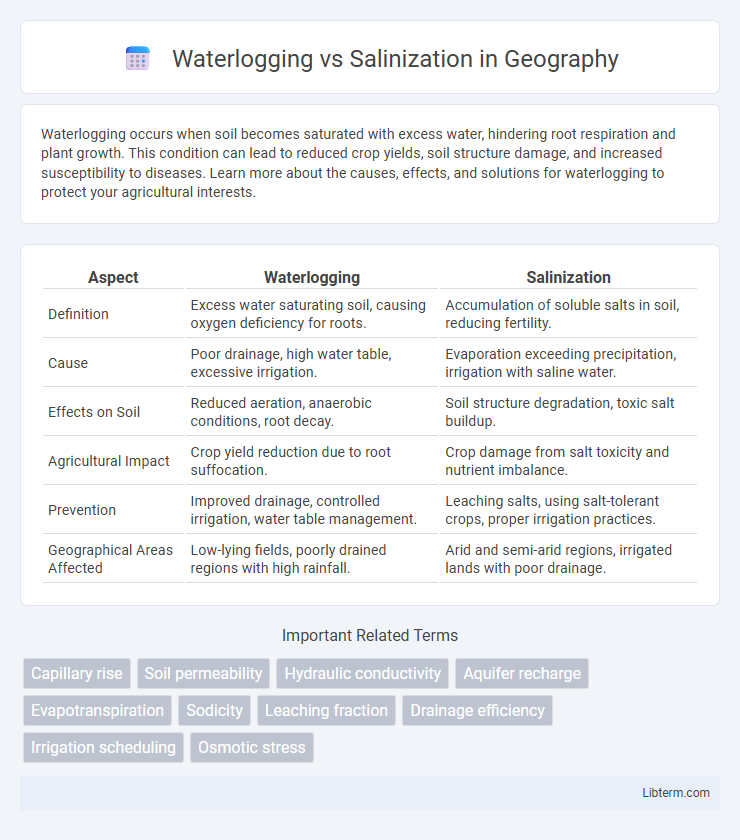Waterlogging occurs when soil becomes saturated with excess water, hindering root respiration and plant growth. This condition can lead to reduced crop yields, soil structure damage, and increased susceptibility to diseases. Learn more about the causes, effects, and solutions for waterlogging to protect your agricultural interests.
Table of Comparison
| Aspect | Waterlogging | Salinization |
|---|---|---|
| Definition | Excess water saturating soil, causing oxygen deficiency for roots. | Accumulation of soluble salts in soil, reducing fertility. |
| Cause | Poor drainage, high water table, excessive irrigation. | Evaporation exceeding precipitation, irrigation with saline water. |
| Effects on Soil | Reduced aeration, anaerobic conditions, root decay. | Soil structure degradation, toxic salt buildup. |
| Agricultural Impact | Crop yield reduction due to root suffocation. | Crop damage from salt toxicity and nutrient imbalance. |
| Prevention | Improved drainage, controlled irrigation, water table management. | Leaching salts, using salt-tolerant crops, proper irrigation practices. |
| Geographical Areas Affected | Low-lying fields, poorly drained regions with high rainfall. | Arid and semi-arid regions, irrigated lands with poor drainage. |
Introduction to Waterlogging and Salinization
Waterlogging occurs when soil becomes saturated with water, causing poor aeration and reduced root respiration, which severely affects crop growth and yield. Salinization involves the accumulation of soluble salts in the soil profile, often due to improper irrigation practices, leading to decreased soil fertility and crop productivity. Both waterlogging and salinization are major constraints in irrigated agriculture, requiring effective drainage and soil management strategies to mitigate their impacts.
Defining Waterlogging: Causes and Symptoms
Waterlogging occurs when excess water saturates the soil, reducing oxygen availability to plant roots and impairing growth. Key causes include poor drainage, excessive irrigation, high water table, and heavy rainfall. Symptoms manifest as yellowing leaves, stunted growth, root rot, and increased susceptibility to plant diseases.
Understanding Salinization: Types and Triggers
Salinization occurs when soluble salts accumulate in soil, impairing plant growth and soil fertility, with primary types including surface salinization and subsurface salinization. Triggers for salinization include poor irrigation practices, high evaporation rates, rising groundwater tables, and inadequate drainage systems. Understanding these factors helps in developing effective soil management strategies to mitigate the adverse impacts of salinization on agricultural productivity.
Key Differences Between Waterlogging and Salinization
Waterlogging occurs when soil is saturated with excessive water, reducing oxygen availability to plant roots and causing root suffocation, whereas salinization refers to the accumulation of soluble salts in the soil, leading to toxic conditions for plants. Waterlogging primarily affects soil aeration and root respiration, while salinization impacts soil osmotic potential, hindering water uptake by plants. Effective management requires drainage systems to prevent waterlogging and salt leaching or reclamation techniques to combat salinization.
Impacts on Soil Health and Crop Productivity
Waterlogging reduces soil aeration, limiting root respiration and nutrient uptake, which decreases crop productivity and increases susceptibility to root diseases. Salinization leads to high salt concentrations in soil, causing osmotic stress and ion toxicity that impair plant growth and reduce yields. Both waterlogging and salinization degrade soil structure and fertility, ultimately compromising long-term soil health and agricultural sustainability.
Environmental Consequences of Waterlogging
Waterlogging leads to oxygen deprivation in soil, disrupting root respiration and reducing crop productivity while promoting the growth of anaerobic bacteria that can produce toxins harmful to plants. It alters soil structure, causing compaction and reducing permeability, which exacerbates surface runoff and increases erosion risk. Prolonged waterlogging also results in nutrient leaching, particularly nitrogen, leading to soil fertility decline and contamination of nearby water bodies through eutrophication.
Long-term Effects of Salinization on Farmland
Salinization causes the accumulation of soluble salts in the soil, leading to reduced soil fertility and impaired plant growth over time. Long-term effects include decreased crop yields, soil structure deterioration, and increased soil erosion, ultimately rendering farmland less productive or even unarable. Persistent salinization threatens food security by limiting the availability of viable agricultural land globally.
Prevention and Management Strategies
Effective prevention and management of waterlogging involve improving drainage systems and promoting soil aeration through techniques such as raised bed planting and crop rotation. Salinization can be mitigated by applying gypsum, implementing proper irrigation management to avoid overwatering, and growing salt-tolerant crop varieties. Both conditions require regular monitoring of soil moisture and salinity levels to ensure timely intervention and maintain soil health.
Innovative Solutions and Technological Interventions
Innovative solutions for waterlogging include advanced drainage systems using geotextile filters and automated water level monitoring sensors to prevent soil saturation and root damage. In combating salinization, precision irrigation techniques like drip irrigation combined with real-time soil salinity sensors optimize water use and reduce salt accumulation. Remote sensing technology paired with machine learning algorithms enhances early detection and targeted remediation efforts, improving overall soil health and agricultural productivity.
Conclusion: Sustainable Practices for Soil Protection
Waterlogging and salinization present significant threats to soil health and agricultural productivity, necessitating sustainable management practices such as improved drainage systems and controlled irrigation techniques. Integrating crop rotation, salt-tolerant plant species, and regular monitoring of soil salinity levels can mitigate these issues effectively. Adopting such strategies ensures long-term soil protection, preserving land fertility and supporting food security.
Waterlogging Infographic

 libterm.com
libterm.com